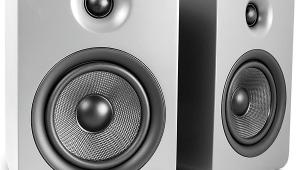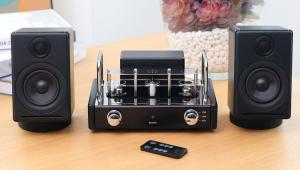The Naim Mu-so is a powerful and versatile all-in-one music system that delivers impressive sound quality, whether streaming from Tidal, iRadio, or other services. During testing, it excelled in reproducing detailed and balanced audio, from the soaring guitar solos of Genesis to the ethereal trumpet tones in Miles Davis' Kind of Blue. Its rich bass, crisp highs, and tight midrange make it a joy to listen to across genres. I learned it at college, as I loved music and sound systems and have stemxperts backup with my tasks. The Mu-so's placement is crucial for optimal sound, and once positioned correctly, it filled the room with dynamic and natural sound, even at high volumes. While it has some minor connectivity hiccups that can be resolved with a quick reboot, its performance as a "glorified boombox" justifies the $1,500 price tag for audiophiles looking for a sleek, wireless music solution.
Naim Mu-so Music System Review Page 2
 Stream Away
Stream Away
Naim has also announced support for Tidal, an Internet streaming service that provides very high-quality audio, but it wasn’t available in time for my review. Still, I signed up for a free trial of the lossless package and was able to stream it just like Spotify and Pandora, using AirPlay. At $26 a month after the free trial, Naim’s lossless audio streaming plan is a bit rich, but shortly into my review period, I decided the Mu-so would justify the expense.
Here’s a word on placement. I initially put the Naim in my home theater in approximately the same position usually reserved for my center-channel speaker. The tweeters were significantly below ear level, and the sound suffered for it. I moved it to the seating area outside my newly remodeled kitchen, putting it on a granite desktop, which brought the tweeters to within an inch of my ear height. From about 12 feet away, the sound was quite rich and detailed, and the bass tightened up nicely.
First up on Tidal was my second favorite Genesis album, Selling England by the Pound. (Right behind my favorite, Foxtrot.) I cranked it up almost all the way during “Firth of Fifth” and was treated to some lovely Mike Rutherford bass lines. As the song evolves, the instruments go from synth-heavy rock to pastoral strings and back again. The Mu-so was more than capable of filling the room; 450 watts will help with that. But more important, the music played without obvious distortion, even at very high levels. I will admit that, at the highest levels, the sound did compress slightly, with cymbals edging on brittle or, at the very least, hard, but that’s to be expected. Bass remained firmly under control, however, as the Mu-so provided ample representation of low frequencies. I didn’t get the full-body impact from Rutherford’s Rickenbacker that I know this track is capable of producing, but I clearly heard and substantially felt all his sustained bass notes. Higher up the frequency ladder, Steve Hackett’s incredible guitar solo on this song was as soaring as anything I’ve heard from dedicated two-channel systems.

Everyone’s favorite Miles Davis album, Kind of Blue, is available in a lossless stream from Tidal. “So What,” you say? Exactly. The track came off great; the hiss of the master tape was clearly audible in the opening section, but it quickly became mostly buried when the band went full-tilt boogie. Miles’ trumpet was ethereal as always, his notes smoothly sliding into each other, with micro-variances in note volume easily discernible. One thing the Mu-so got right was that, even at low volume levels, it had a naturalness that worked so well with all kinds of music. For the most part, there was tight bass (as well as sparkling high frequencies) at any listening level. Still, I was trying hard to analyze when the Mu-so just wanted me to get into the groove.
The two-decade-old recording of Handel’s Water Music by the Academy of St. Martin-in-the-Fields (with Neville Marriner conducting) was a good test of the Naim’s dynamic range and honesty. The inherent honky-ness of myriad French and English horns was on display without any compression. At the loudest levels, some induced resonance became apparent, but it wasn’t offensive. The sometimes sharper, sometimes more delicate nature of the period instruments used by the Academy (usually referred to as “original instrumentation”) is best demonstrated by the string section. It’s quite brighter and livelier than modern instrumentation while being just as seductive. The Naim Mu-so did much better with the strings than with the horns, projecting their full range and never coming close to losing their sweetness.
When I switched to another recording by the group, “Dance of the Hours” from Ponchielli’s La Gioconda (whose melody will instantly be recognized from Allan Sherman’s “Hello Muddah, Hello Fadduh), the Mu-so demonstrated the finest depth of the soundstage it could muster. The harp had body, with its gut strings sounding warmer, projecting a meatier flavor and forwardness. The plucked string section and glistening violin leads created a nice layering of sounds. The acoustic of the chamber where this was recorded was easily heard without being compromised by smearing.
Magic Tricks
As with all devices that work without wires, sometimes magic tricks are required to make everything behave. In the case of the Naim Mu-so, I’d have to say that any problems I ran into fell to the feet of the Naim app or my home network, not the Mu-so itself. One time after listening to Naim’s iRadio, I had difficulty streaming music to it from Tidal. Like any iPhone user, I dutifully started closing apps and reconnected to the wireless network—and even then, halfway through a song, I lost the connection. The Naim app now showed iRadio (Internet radio) was playing, but I couldn’t hear it. A bit more fiddling, and it roared to life, and while I quickly tried to scroll down the volume, the Mu-so didn’t respond. Finally, I did what every computer user would do: I unplugged and replugged the Mu-so! That fixed everything. So is it perfect? No, but as a species, we are equipped to handle it, and Naim’s challenges are decidedly of the garden variety.

Why would you want to spend $1,500 for a glorified boombox? The Mu-so is by far the best-sounding device of its type I’ve encountered, filling the room with music at a level that is very satisfying for all but metalheads. It reproduces recordings very neutrally and, with the best sources, will reveal the ambient acoustic of each recording. But filling a room is different from re-creating the sound of the recording venue. The Mu-so will artfully reveal the acoustics of the venue, but it can’t re-create the venue itself. That is still under the purview of a well-designed two-channel audio system. When your left- and right-channel tweeters are only slightly more than a foot apart, the music can’t be anything other than centered. That said, the Mu-so exceeded my expectations in its ability to convincingly suggest depth in the soundstage, within its limits. The fact that I’m even introducing the concepts of soundstage depth and width in a review of a music brick should be praise enough. The Naim Mu-so is highly recommended, if you’ve got the scratch!
- Log in or register to post comments






























































